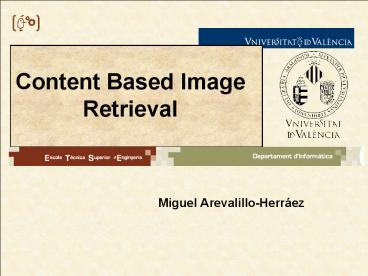Content Based Image Retrieval - PowerPoint PPT Presentation
1 / 29
Title:
Content Based Image Retrieval
Description:
Content Based Image Retrieval Miguel Arevalillo-Herr ez Contents Introduction Information retrieval Image retrieval CBIR Approaches Combining similarity measures ... – PowerPoint PPT presentation
Number of Views:776
Avg rating:3.0/5.0
Title: Content Based Image Retrieval
1
Content Based Image Retrieval
- Miguel Arevalillo-Herráez
2
Contents
- Introduction
- Information retrieval
- Image retrieval
- CBIR
- Approaches
- Combining similarity measures
- Full CBIR systems
- Possible extensions to 3D
- Results and Conclusions
3
Concepts
- Information retrieval
- Objects are documents
- Concept of a query
- Image retrieval
- Objects are images
- Concept of a query
- Content Based Image retrieval
4
Common setup for CBIR
5
The method
- How do we judge how similar two images are?
6
The method
- How do we judge how similar two images are?
- - feature vectors
7
The method
- How do we judge how similar two images are?
- - feature vectors
- How do we compare these vectors?
8
The method
- How do we judge how similar two images are?
- - feature vectors
- How do we compare these vectors?
- distance funcions defined over the feature space.
9
The method
- How do we judge how similar two images are?
- - feature vectors
- How do we compare these vectors?
- distance funcions defined over the feature space.
- How are these distances combined to yield a
composite similarity value?
10
The method
- How do we judge how similar two images are?
- - feature vectors
- How do we compare these vectors?
- distance funcions defined over the feature space.
- How are these distances combined to yield a
composite similarity value? - Normalization and combination
11
The method
- How do we judge how similar two images are?
- - feature vectors
- How do we compare these vectors?
- distance funcions defined over the feature space.
- How are these distances combined to yield a
composite similarity value? - Normalization and combination
- How are multiple selections combined?
12
The method
- How do we judge how similar two images are?
- - feature vectors
- How do we compare these vectors?
- distance funcions defined over the feature space.
- How are these distances combined to yield a
composite similarity value? - Normalization and combination
- How are multiple selections combined?
- Multiple selection approaches
13
The method
- How do we judge how similar two images are?
- - feature vectors
- How do we compare these vectors?
- distance funcions defined over the feature space.
- How are these distances combined to yield a
composite similarity value? - Normalization and combination
- How are multiple selections combined?
- Multiple selection approaches
14
Normalization and Combination Rules
- Classical normalization rules
- Gaussian
- Linear
- Classical combination rules
- Sum
- Product
- Linear combination
15
Probabilistic Approach
- For each distance function we estimate the
probability that the user considers that two
images are similar, for every possible distance
value p(similar di) - This is performed from a training set
16
Probabilistic Approach
- For each distance function we estimate the
probability that the user considers that two
images are similar, for every possible distance
value p(similar di) - This is performed from a training set
- p(similar d1, d2, d3,,dn) ?
- p(similar d1) x p(similar d2) x p(similar
d3) x x p(similar dn)
17
Handling Multiple Selections
- Classical Approaches
- Query point movement and axis re-weighting
- Support Vector Machines
- Probabilistic and Regression Approaches
- Other interesting approaches
- SOM based
- Nearest neighbour
18
Fuzzy Approach - Concepts
- Need to deal with uncertainty of the data
- Classical set
- Elements are or are not in the set
- Fuzzy set
- Elements have a degree of membership to the set
19
Fuzzy approach
- Assumes an underlying search model
- Any image of interest should be perceptually
similar to each of the pictures in the set
Positive in at least kpos characteristics. - Any image of interest should be perceptually
different from each of the pictures in the set
Negative in at least kneg characteristics.
20
(No Transcript)
21
Fuzzy approach
- Every iteration the user is more exigent
- Kpos and Kneg vary at each iteration
22
Fuzzy Approach
23
Genetic Approach
- An evolutionary algorithm attempts to solve a
problem applying Darwins basic principles of
evolution on a population of trial solutions to a
problem, called individuals.
24
Genetic Approach
25
Genetic Approach
- Key issues
- Existence of fitness function
- Relevance feedback defines population and fitness
- Maintaining consistency
- How do we judge next generation?
26
Genetic Approach
27
Genetic Approach
28
Possible extensions to 3D
- How do we judge how similar two images are?
- - feature vectors
- How do we compare these vectors?
- distance funcions defined over the feature space.
- How are these distances combined to yield a
composite similarity value? - Normalization and combination
- How are multiple selections combined?
- Multiple selection approaches
29
Results and Conclusions
- Introduction to the CBIR problem
- Feature extraction
- Definition of distance funcions normalization and
combination - Handling multiple selections
- Posible extensions to 3D

